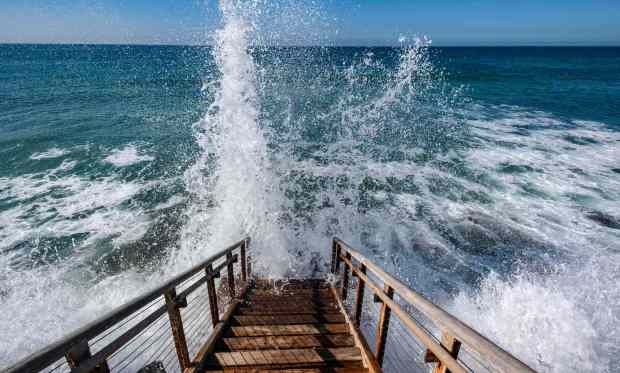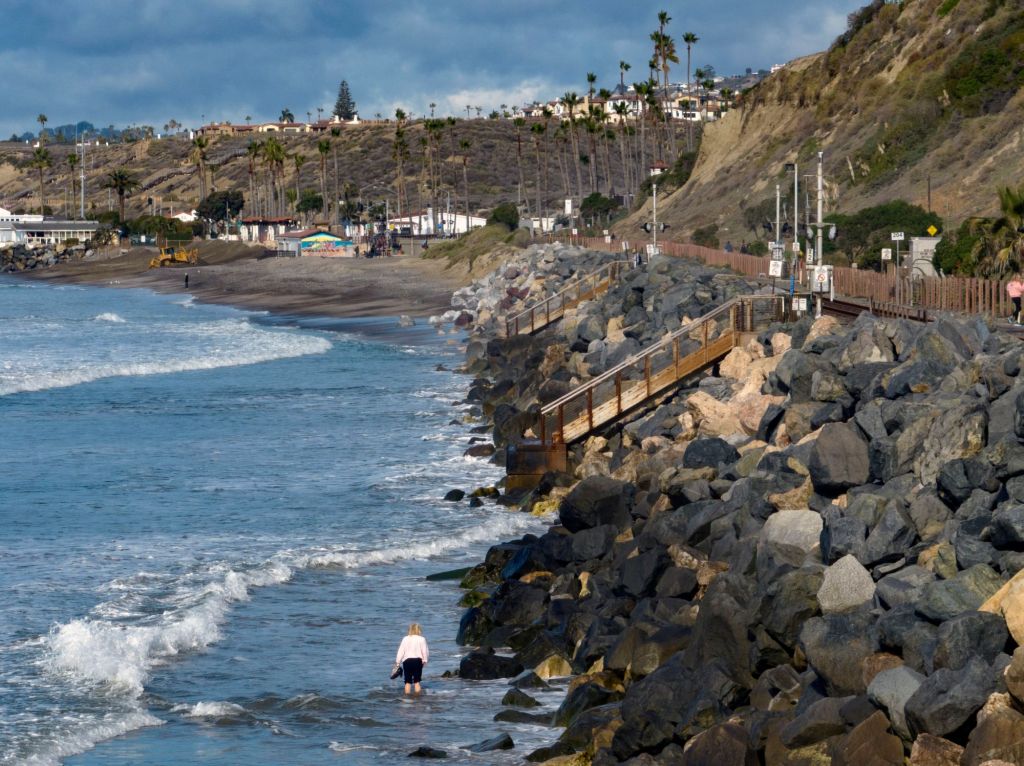The Orange County Business Council most recently cast its attention to an economic sector that is vital to the region’s growth and fortunes — its coast.
“A third of Orange County’s economy is based on our coast,” Orange County Fifth District Supervisor Katrina Foley told a recent gathering hosted by the business council in Newport Beach to address growing concerns about beach erosion and disappearing sand, vital to everything from tourism to jobs, property taxes to recreation, presenters emphasized.
“For every dollar we invest in sand, we get $3,000 dollars back – let that sink in,” Foley shared, noting 75% of Americans say they choose the beach when they go on vacation. “We must keep our beaches, so we have all these tourists.”
The discussion, “Addressing the Economic Impacts of Beach Erosion,” brought together experts and leaders to talk about troubles facing the region, how the coast fuels the economy here and across the state, and the challenges in obtaining the supplies and funding to keep beaches sandy.
Brett Sanders, professor of civil and environmental engineering at UC Irvine, gave an overview to the group at Marina Park, detailing which beaches have plenty of sand and others that are struggling, many in south Orange County.
Sanders spoke about developments and man-made structures that impede sand supply from naturally making its way to the coast, one of the main reasons beaches are shrinking.
Sanders and several other speakers talked about the challenges obtaining sand to bring to the beach to replenish the supply — a race against time as beaches continue to erode.
Dave Dzwilewski, vice president of sales for Gale Materials Inc., gave insight into the current inland sand supply and the cost to acquire the commodity. The company uses sand for building streets, sports parks and golf courses, among other projects.
Sand for concrete costs about $22 a ton. But finer sand — the kind that would be used at the beach or for a park project — sells for $50 a ton.
And the allowed quarries that exist nearby are running dry — 50% of all sand used for Southern California projects is being brought in from Baja or British Columbia, Dzwilewski said.
His company is not alone in eyeing the sand, about 750,000 cubic yards, piling up at Prado Dam as a source, but permitting has proven too difficult.
“There is so much sand in Southern California, but permitting is always a problem,” Dzwilewski said.
The biggest sand supply available right now is the desert, he said, with a new sand plant that opened up two years ago.
Foley, who moderated a panel discussion, also talked about the challenges of acquiring sand at Prado Dam. The sand is being eyed by local agencies for beach replenishing, but also to protect a rail line in South Orange County, where waves are threatening the tracks because the beach buffer has eroded.
“We missed the window,” she said of trying to get the necessary permits through the US Army Corps of Engineers, “but we’re on track for next fall.”
Talking about beach economics, she discussed tourism, but also property values and the losses from beach erosion.
“So protecting the beaches is good for the coastal economy, good for tourism, good for property values, for revenue into the counties, it’s also good for protecting our rail corridor,” she said.
Foley and the other county leaders have taken several steps in recent years to try and find solutions. They created the South County Beach Coalition – something recommended a decade ago but shelved until recently – and hired a “coastal resiliency manager” to develop a plan to protect the coast.
 With no beach left, a wave crashes against the rocks and stairs just below the railroad tracks at North Beach in San Clemente on Wednesday, Oct. 20, 2021. No sand means less visitors, impacting the economy, experts argue. (Photo by Mark Rightmire, Orange County Register/SCNG)
With no beach left, a wave crashes against the rocks and stairs just below the railroad tracks at North Beach in San Clemente on Wednesday, Oct. 20, 2021. No sand means less visitors, impacting the economy, experts argue. (Photo by Mark Rightmire, Orange County Register/SCNG)
An $11 million breakwater repair at Dana Point Harbor will also add about 45,000 cubic yards of sand to nearby Doheny State Beach, Foley shared.
Assemblymember Diane Dixon, R-Newport Beach, said what happens to local beaches impacts all of California and beyond.
“It’s not just recreation, it’s vital to the state of California. The property tax dollars and home values, the business taxes generated from Orange County beach communities are essential to the state of California,” Dixon said. “We have a real issue, and an opportunity to ensure we protect our beaches.”
There are 87,000 Newport Beach residents, but about 10 million people visit each year. Huntington Beach and other coastal towns have similar reliance on tourism — and the dollars they bring — to support their communities, Dixon noted.
“That is essential to our communities,” she said. “The beach portion of those cities will erode — the way the sand is eroding — and destroy the economic foundation of our communities.”
Heather Johnston, executive director of Visit Dana Point, talked about the beaches as an economic driver, bringing people to stay at hotels, visit restaurants and employ thousands of people.
“It is something that is absolutely vital,” she said of the coastline. “When our beaches lose the sand, we absolutely lose hundreds of thousands of dollars in overnight stays in our local businesses.”
Ad campaigns always showcase the beaches and coastline in marketing, she noted.
“People take it for granted — the beaches are always there, the sand is always there, people are going to come,” she said. “It affects us in so many ways. We all love the beaches, we all love the coast. It’s an environmental issue, but it is absolutely an economic issue.”

